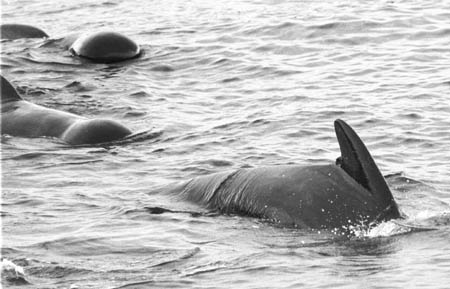Honours Research
In May of
2000, I completed my honours Bachelor of Science degree at Dalhousie University.
I examined the distribution of cetacean species in St.Lawrence Bay and how
they related to
prey distribution and sea surface temperature. My data
was collected from a commercial whale
watch operating out of the small village of Bay St. Lawrence in northernCape
Breton Island,
Nova Scotia.
Abstract
The waters surrounding the northern tip of Cape Breton Island, Nova Scotia
support a diverse marine fauna including large numbers of seabirds, fish,
seals and cetaceans. Although this area appears to be important for cetaceans,
little research has been conducted on the status and distribution of these
species in this area. This study attempts to describe the distribution of
six cetaceans which are observed in St. Lawrence Bay which is found on the
northern tip of the island. It also attempts to correlate cetacean distribution
with sea surface temperature and prey abundance (mackerel catch in kg). Observations
of cetaceans has been collected by Captain Cox’s Whale Watch from 1989
-1999 and provides the only long-term data set regarding cetacean occurrence
in northern Cape Breton. The main species observed in this area are: long-finned
pilot whale (Globicephala melaena), minke whale (Balenoptera acutorostrata
), fin whale (Balenoptera physalus), humpback whale (Megapteranovaeangliae
), white-sided dolphin (Lagenorhynchus acutus), white-beakeddolphin(
Lagenorhynchus albirostris) and harbour porpoise (Phocoenaphocoena
).
A total of 1319 trips were conducted by this whale-watch between 1992 and
1999. Of these 1319, 1192 trips encountered at least one of the seven cetaceans
species. Thus, it is obvious that cetaceans frequently use St. Lawrence Bay.
Simple linear regression and a repeated measures analysis of variance was
used to determine if trends within a month over years exist and if differences
exist between overall monthly and yearly sighting rates for each of the species.
It was determined that significant differences existed between months and
years for only minke and fin whales and that there was a significant
linear trend in sighting rate of dolphins in September. A significant relationship
was detected between the sighting rate of pilot, minke and humpback whales
and sea surface temperature. However, no significant relationships existed
between any cetaceans and prey abundance.
Pilot and minke whales are the most commonly observed cetaceans in St. Lawrence
Bay. Their distribution appears to follow the distribution of spawning mackerel
and herring which enter the Gulf of St. Lawrence through the Cabot Strait,
a deep channel adjacent to St. Lawrence Bay, in spring and summer and leave
in late summer/early autumn. The larger baleen whales and harbour porpoises
are likely entering the bay opportunistically taking advantage of aggregations
of prey, primarily schooling fish such as mackerel and herring. As the dolphins
were unable to be separated into species, it was difficult to make any conclusions
about their distribution and relationship to sea surface temperature andprey
abundance.

Return to Tonya Wimmer's homepage
Return to the Whitehead Lab
homepage
